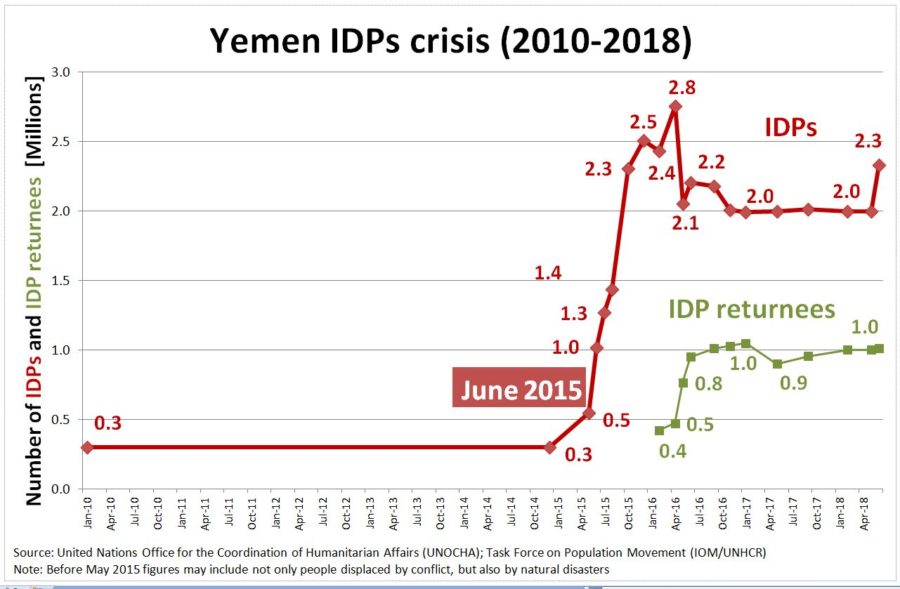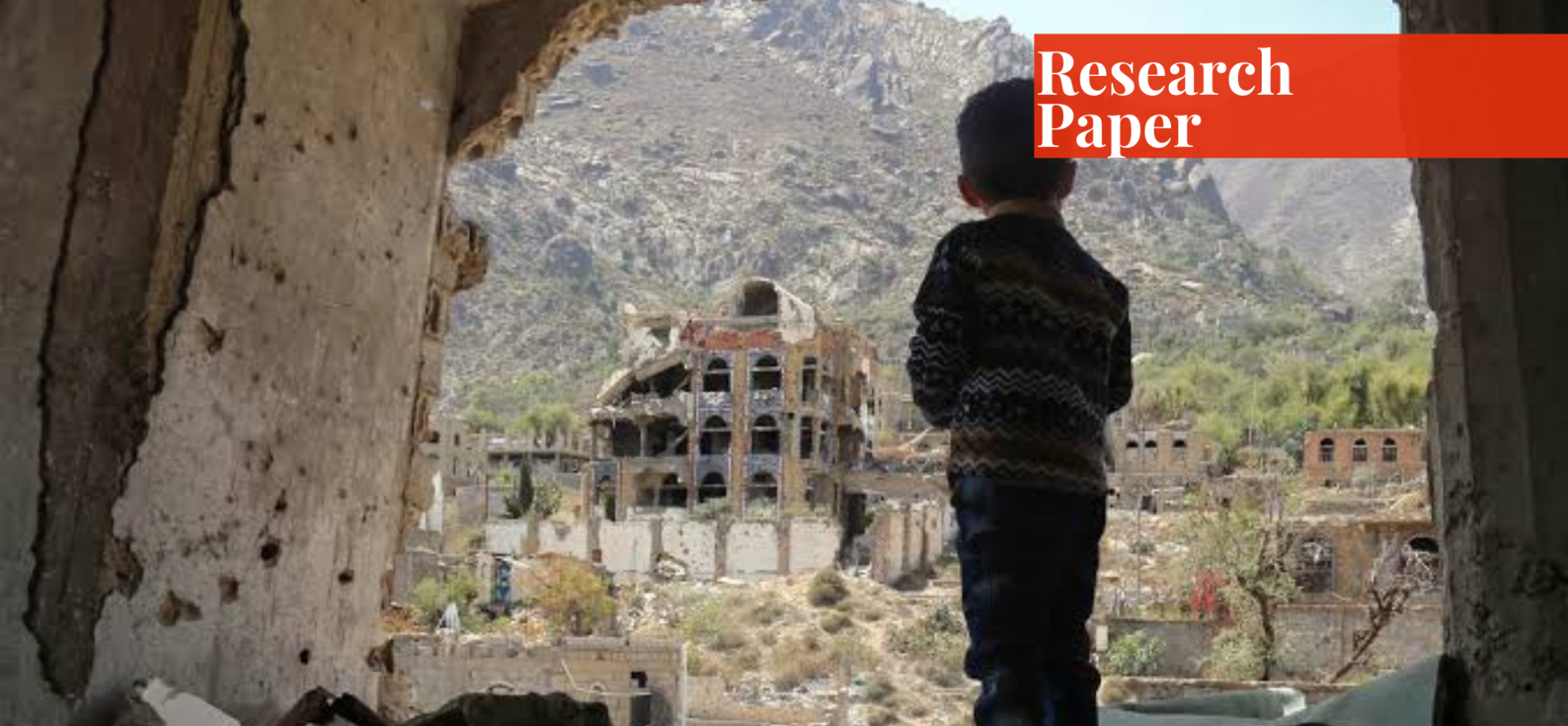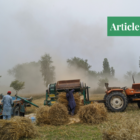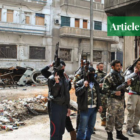Farhan Ijaz is a student of BS International Relations at Bahauddin Zakariya University, Multan. He is interested in the geopolitics of the Middle East, Central Asia, and South-East Asia.
Introduction
The future of the ongoing civil war in Yemen depends upon the political rivalry among the major regional powers. The population of Yemen, especially children, has to face severe repercussions from this conflict. The government of Yemen has breached the UN Convention on the Rights of the Child by violating the basic rights of children.
The Houthis, the Saudi-led coalition, and the fragile Yemeni government are all responsible for the deteriorating plight of the children in Yemen. Children are not only vulnerable to violence but diseases and hunger. The prevalence of chronic diseases has furthered the grievances of children, leading them into a state of continuous trauma. Children are devoid of education, nourishment, and healthy growth which has affected their psychological and physical well-being. As a result, their future is questioned in a technologically advanced and global world.
Amid all these situations, the role of the concerned state and non-state actors is disappointing. Their preference for their selfish interests over human security and developments has dragged Yemen into the worst humanitarian crisis. This conflict, where the world’s superpower – the USA – is also complicit, doesn’t seem to be ending soon amid changing geopolitical scenarios. Five years after the start of the civil war in Yemen, the US continues to support a Saudi-led coalition accused of war crimes (Preve, 2020). Political settings in Yemen are also contributing to this vehemently worsening crisis.
Background of the Civil War in Yemen
The conflict in Yemen began when Houthis rose against the government of Abd Rabbu Mansour Hadi and took control of Yemen’s capital Sana’a in 2015. Soon the region became a battleground for the proxy war between Iran and Saudi Arabia. Iran allegedly backed Houthi rebels belonging to the Shia sect of Islam and Saudi Arabia supported the Sunni government of President Hadi in Yemen. The conflict escalated when the former Yemeni president, Ali Abdullah Saleh, formed a coalition with the Houthis against the Hadi government but the alliance proved futile.
On the other hand, Saudi Arabia formed a coalition with other Arab countries to halt Iran’s influence in the region. The Saudi-led coalition bought weapons from the USA, UK, and Canada to fight against Houthi rebels supported by Iran. Arms shipments to Saudi Arabia now account for more than 75 percent of Canada’s military exports to countries other than the United States (Chase, 2020).
The coalition forces carried out airstrikes and naval blockades to counter the Iranian support to Houthis through maritime routes. This, in turn, led to the destruction of infrastructure and hindered the humanitarian aid reaching the Yemeni people amid the crisis. Now the people of Yemen were struck in the full-fledged conflict between the Houthi rebels and the Saudi-led forces, which undermined the human rights regime in Yemen. The conflict has not ended even after 7 years, with the most recent agitation being the attacks on Saudi Aramco sites by Houthi rebels in 2021.
The UN Convention on the Rights of the Child
The United Nations emerged with an agenda of peace, security, and development; it professes human rights more than anything. Most of the existing human rights regimes are recognized or respected because the 193 signatories of the UN endorse them. The United Nations Convention on the Rights of Child (1989) provides children with basic rights and states an obligation to protect and respect those rights. According to the convention, anyone under the age of 18 years is considered to be a child.
The rights discussed in this convention include life survival, development, indiscrimination, access to education, protection in war, keeping families together, the responsibility of parents, and special treatment for children with disabilities. All these rights depict children as equal all over the world, regardless of their color, religion, and race.
However, despite the existence of the UN Charter and the convention on children’s rights, the plight of the Yemeni children raises serious questions on the efficiency of the UN. The regional powers supporting hostilities in Yemen are also members of the UN, but they have placed their political goals above their obligation to human rights.
Violation of Children’s Rights in Yemen
Children constitute a major portion of the total population of Yemen; almost 46% of the population is under 18. Out of the 24 million people in need of humanitarian assistance, half are children. According to the human rights regime, there should be a special focus on children’s rights in a country with that much children population. However, the regional human rights regimes are often conflicting in nature.
When it comes to the violation of children’s rights in Yemen, all of the major players have played their utmost parts in worsening their situation, be it the Saudi-led coalition forces, the Houthi rebels, or the USA, which is the main arms supplier to the Saudi-led coalition forces in the civil war in Yemen. The participants of the war are neither abiding by the RPF (Respect, Protect, Fulfil) framework of human rights—which provides a ground for the analysis of the human rights situation in Yemen—nor the 1949 Geneva Conventions on war, even though they are a signatory of it (Tayara, 2021).
According to the framework and conventions, it is the responsibility of the Yemeni government to protect the state’s children. But the children are not just being affected by the conflicts but are also taking part in it, through illegitimate recruitment into both Houthi and Saudi-led coalition forces.
This interplay of regional powers seeking influence has left Yemen economically and politically dismantled with little resources for development. The major areas where the children of Yemen are lacking due to the inefficiency of the local government and the uninterested behavior of the international community are listed below:
Food Insecurity
Almost 24 million people in Yemen need humanitarian assistance (UN, 2019). Major assistance is needed to fulfill the basic human needs and for having balanced, nutritious food. Political instability, war, and natural calamities, including famine-like situations, have caused food insecurity for the Yemenis.
Its impacts are evident on women and children. Malnutrition among children due to lack of nutritious and quality food is rising swiftly. Pregnant women and children need timely treatment for acute malnutrition. Several factors have led to this level of food insecurity in Yemen.
The blockade of ports and the devastated infrastructure are the major obstacles in the path of assistance reaching the poorer areas. Ultimately, food prices in Yemen are increasing. Almost 16.2 million Yemenis are facing food insecurity while humanitarian assistance is projected to feed 13 million people using all their means. This alarming situation is pushing Yemen to the verge of deadly famine.
Children Army
As per the rules of war declared in the Geneva Conventions, child recruitment in fighting groups is a grave violation of their rights. Despite its obligation to the Geneva Conventions, the Yemeni government, along with the Saudi-led coalition forces, is recruiting children under the age of 18; hence, committing a grave violation of children’s rights in Yemen. Children in Yemen are accustomed to the use of ammunition to such an extent that it has acquired the shape of a norm.
The lack of education, humanitarian assistance, and human development have allowed children to be exploited by the parties of the conflict in return for a handsome amount of money. Many children get killed in airstrikes or direct confrontations, whereas their families get a few dollars in return.
According to a survey by the United Nations Children’s Emergency Fund (UNICEF), at least 2,149 children have been recruited to fight since 2015 by the Houthis and the Saudi-led coalition forces. According to the U.N. reports, around 1,300 children have been killed and an equal number have been injured by the Saudi-led coalition airstrikes in Yemen since March 2015 (Schlein, 2018).
This highlights the immorality of the warring parties who are neglecting their moral duty to protect the children’s rights in Yemen just to pursue their political aims. The Yemeni children are being deprived of their basic rights, mentioned in the UN Convention on the Rights of the Child, that provide them protection in war and from dangerous jobs.
Lack of Education
Lack of education is a major contributing factor when it comes to worsening the situation of the children of Yemen. A large number of children do not attend schools due to the fear of airstrikes on school buildings. The number of children out of schools is mounting to 2 million after the escalation of the conflict in 2015. The empty buildings of the schools are used for other purposes, like a shelter for the displaced population.
The Saudi-led coalition forces justify their attacks on schools and hospitals by labeling them as safe places for the Houthis. The 2018 attack on a school bus, by the Saudi-led coalition forces, highlights the inefficiency, and negligence of the forces towards children and civilian lives (Edroos and Algohbary, 2018).
These attacks are based on miscalculations done by the coalition forces that fail to take into account the proximity of the target to hospitals or schools. The coalition’s refusal to be bound by the UN Convention on the Rights of the Child highlights their unwillingness to accommodate children’s interests.
Moreover, the teachers in public schools have not been paid for more than a year, resulting in increased feelings of demotivation and hopelessness. The ongoing civil war in Yemen, airstrikes, poor infrastructure, low standard of education, all these factors are putting the education of the remaining students at a greater risk. It is feared that these factors combined will leave an entire generation of Yemeni children uneducated and deprived.
Chronic Diseases
The humanitarian crisis in Yemen is further aggravated by the outbreak of infectious diseases like cholera, COVID-19, and vector-borne diseases. Insufficient medical assistance and medicine shortages combined with malnutrition have raised severe health security concerns.
Yemen had an outbreak of cholera due to poor sanitation conditions and a lack of safe water. The problems with the cholera vaccination drive worsened the situation. Children could not get vaccinated on time which led to an increase in infectious diseases. Almost 193 child deaths were reported officially.
Moreover, the COVID-19 pandemic also affected the already vulnerable population of Yemen. Yemen reported more than 620 deaths with 2,070 confirmed cases of COVID-19 in 2020. The ceasefire due to the pandemic also halted the humanitarian aid from reaching the Yemeni people. Inadequate medical facilities, withdrawal of doctors, and the lack of health workers and medical equipment have increased malnutrition and other health issues in children.
Internally Displaced Children
Displacement is an important feature of a conflicted region. Yemen, being a highly conflicted region, has a large number of internally displaced persons (IDPs). Children constitute a major portion of the total number of IDPs. The ongoing conflict between the Houthis and Saudi-led coalition forces, marked by airstrikes, has destroyed the infrastructure, resulting in the displacement of people. Within the first year of the conflict, the number of IDPs in Yemen surged to 2.8 million from 500,000. Whereas, in 2019 alone, the total number of internally displaced children was 19 million.

Houthis have planted landmines to halt any humanitarian assistance directed towards the affected areas. As a result of these mines, the movement is limited in these areas and people are facing difficulties in performing their routine works. Therefore, most of the families are leaving these areas. With many being orphaned, there is a limited number of places to cater to their needs, forcing many to move to other regions.
Moreover, children’s recruitment in armed groups is another major cause of displacement. Children’s right to a safe home under the UN convention is once again violated by the perpetrators of the conflict, leaving many in deplorable conditions.
Forced Marriages and Child Labor
The conflict in Yemen has affected the lives of children indiscriminately. The conflict has incurred severe damages to the social lives of both girls and boys. There reduced prospects for children due to lack of education, employment, and development has resulted in parents forcing their daughters to get married at a very early age.
The major motive behind this is the hope that their basic needs might be met in their husband’s home. According to a report by UNICEF, almost 1.4 million girls got married before the age of 15. These girls accounted for 9% of the total female population of their age.
Child labor is another outcome of the conflict that has disturbed the socio-economic development of the country. Children get exploited sexually, serve as cheap labor, and get involved in the conflict by joining either armed group. According to a survey, 1.3 million children work as laborers in Yemen, and most of them do not get paid.
Mental Trauma and Psychological Impacts
The mental health of the children in Yemen is affected vehemently. Losing friends and family members in the blink of an eye leaves a child in a state of trauma for the rest of his life. According to a survey conducted in 2018, 79% of children showed serious psychological distress as a result of the deadly conflict. A plethora of stories circle on the electronic and social media where children are seen explaining the psychological impacts of the war. Additionally, the lack of psychiatrists working in Yemen adds to this disturbing predicament of the children.
Role of State and Non-state Actors
In a globalized world, humanitarian crises need the attention of the world powers. The success of the current international political system, comprising of state and non-state actors, to avoid conflicts is questionable. Yemen crisis allows analysts to evaluate the nature and roles of state and non-state actors in conflicting situations. Where non-state actors, like the UN and other organizations working for the protection and promotion of human rights, are providing humanitarian assistance while state actors, including international and regional influencers, are contributing to worsening the human plight in Yemen.
Initially, the war broke out between the local government and the Houthis in Yemen and further escalated into a civil war backed by the regional powers supporting warring groups. The civil war in Yemen provided an opportunity for international powers to maneuver regional players and achieve their geopolitical aims.
The US supported the Saudi-led coalition forces against Iran in the Yemen civil war and sold them arms and ammunition, which was mostly used on innocent people. On the other hand, the Houthis, being Shiites, are morally supported by Iran. They provide Iran with an opportunity to increase its influence in the Middle East by forming its pro-Iran government in Yemen.
The American economy is popular as a war economy as Americans know how to grow their economy in war times by selling their weapons. The arms deal was not only offered by the US but by France, Britain, and Canada as well. Since the usage of internationally banned cluster ammunition by the coalition forces was a serious issue, some of these countries halted the arms supplies in the wake of a violation of the laws of war by the Saudi-led coalition forces.
However, they soon resumed the arms trade to achieve their geopolitical and material aims. The US Congress was concerned about the arms sales to the coalition forces as it could lead to the US officials being held guilty of war crimes. There is no doubt that the US is complicit in war crimes in Yemen. The interplay of these actors has caused grave violations of children’s rights in Yemen.
The blockade across the routes through which humanitarian aid reached the Yemenis, has barred the functioning of the NGOs and other organizations working for human rights and assistance. Moreover, the destroyed infrastructure and the regulatory impositions by Houthis have proved to be a major hindrance in humanitarian assistance reaching the affected communities.
Although the measures taken by the UN are not sufficient, the steps taken, so far, also have to face challenges. The UN General Secretary Antonio Guterres included the Saudi-led coalition in the “list of shame” but removed it when Saudi Arabia refused to grant funds for the UN functioning.
The Saudi-led coalition forces not only violated the laws of war but also bullied the UN, to which it has binding obligations (Nichols, 2020). This hostile attitude of the state actors, towards the UN Charter and the organization’s conventions, raises serious questions about the future of Yemen and its people. The political instability, civil war, and grave violations of human rights have rendered Yemen a failed state, with the future of an entire generation at stake.
Conclusion
The deadly civil war in Yemen can be said to have marked the end of an entire generation. A country with a population containing more than 12 million children is under siege by poverty, lawlessness, malnutrition and deprivation. The indiscriminate airstrikes, blockade of humanitarian aid, forced marriages, child labor and displacements on a huge scale, constitute only a small group of agonies that the Yemeni children have to face in their day-to-day lives.
This humanitarian crisis, in the contemporary world, poses a serious challenge to the human rights regime and its protagonists. The deliberate opposition of the regional powers to political stability and human rights protection in Yemen, and the subsequent silence of the international community, raises moral questions on the duality of the international powers and the human rights regimes. The physical and mental health of an entire generation is at stake in the largest humanitarian crisis of this era and if not dealt with timely, it can become a huge burden on the shoulders of the international society.
References
- Chase, S. (2020, September 17). Trudeau urged to end arms exports to Saudi Arabia after Canada cited for fueling Yemen war. The Globe and Mail. https://www.theglobeandmail.com/politics/article-trudeau-urged-to-end-arms-exports-to-saudi-arabia-after-canada-cited/
- Edroos, F. and Algohbary, A. (2018, August 16). Yemen Bust Massacre: How a joyful excursion ended in sheer horror. Al-Jazeera. https://www.aljazeera.com/features/2018/8/16/yemen-bus-massacre-how-a-joyful-excursion-ended-in-sheer-horror
- Nichols, M. (2020, June 16). Saudi-led coalition cut from U.N. backlist of warring parties killing children. Reuters. https://www.reuters.com/article/yemen-security-un-idINKBN23N0CT
- Preve, A. (2020, March 19). The US is complicit in Saudi atrocities in Yemen. Al-Jazeera. https://www.aljazeera.com/opinions/2020/3/19/the-us-is-complicit-in-saudi-atrocities-in-yemen
- Schlein, L. (2018, October 11). UN Committee Blasts Saudi Arabia on Yemen Child Deaths. Voice of America. https://www.voanews.com/a/un-committee-blasts-saudi-arabia-on-yemen-child-deaths/4609668.html
- Tayara, S. (2021, March 17). The plight of Yemeni Child: Seven years of ongoing violations. Human Rights Pulse. https://www.humanrightspulse.com/mastercontentblog/the-plight-of-the-yemeni-child-seven-years-of-ongoing-violations
- UNICEF. (2018, November 4). Conflict in Yemen: A living Hell for Children. https://www.unicef.org/mena/stories/conflict-yemen-living-hell-children
If you want to submit your articles and/or research papers, please check the Submissions page.
The views and opinions expressed in this article/paper are the author’s own and do not necessarily reflect the editorial position of Paradigm Shift.



















